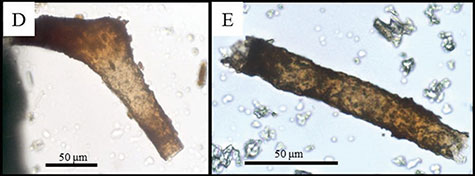Purpose
In 1997, paleontologist Dr. Mary Schweitzer accidentally stumbled upon what appeared to be blood vessels and blood cells from a T. rex bone.1 Proliferating publications of apparently intact tissues, including branching blood vessels, from long-buried dinosaur bones led ICR to begin its own dinosaur soft tissue research. Biomaterials like blood vessels or even mere protein remnants present a serious challenge for the deep times assigned to the fossils they come from.
Methods
We began a literature search in 2008. By 2013, we had compiled about 40 technical articles that described original biochemistry in fossils.2 In God’s providence, that initial report led to collaborations on original research, which blossomed for me into a Ph.D. in paleobiochemistry in 2019.
In my year of graduation, the list had more than doubled. Our 2019 review paper cited our first-ever use of second-harmonic generation imaging of fossil bone collagen remnants, alongside 85 other reports of biomaterials in fossils from around the world.3 Conventional paleontologists had by then used over 30 techniques to verify whole tissues, including branching blood vessels, from fossil bones in at least three countries.
Our research, funded by ICR donors, aims to resolve answers to two questions. First, can these biomaterials come from any source other than the animals that were buried in the rocks? For this, we bring novel instrumentation or techniques to fossils in an attempt to more accurately characterize residual biomaterials such as proteins.
Second, how long can these biomaterials last in optimum conditions? For this, we apply novel techniques to more precisely characterize expected decay rates and thus shelf-lives. Our most recent study, done in partnership with the Creation Research Society, verified a new protein decay rate protocol.4
Results

Our results thus far confirm the presence of bone collagen in some Mesozoic samples. Collaborators have actually sequenced bone collagen from a hadrosaur from Montana. We plan to submit the results to a conventional journal for publication to help dissolve false accusations of bias in creation research. When published, we will thereby add to conventional findings of young-looking biomaterials like osteocalcin, collagen, elastin, branching blood vessels, and cell structures, including nuclei containing genetic material.
Overall, we have not yet found a more reasonable source for these vertebrate-specific biomaterials than the buried animals themselves. We plan to continue characterizing original fossil proteins using new collaborators, instruments, techniques, and fossils as they become available.
Finally, preliminary results from our decay rate experiments suggest that the published decay rate for collagen may be too low. These experiments take a long time to perform because collagen is so tough. If confirmed, this would spell bad news for those who wish collagen could last millions of years. Bone collagen—as opposed to collagen in cartilage, epithelium, or elsewhere in a vertebrate body—can last thousands, but not millions, of years based on repeatable experiments.
Impact
Each new experiment on biochemical decay rates and each new discovery of apparently original biochemistry in fossils tighten the screws on evolutionary time and thus open wider the doors that lead to biblical creation and a recent Noah’s flood. These really do look like Flood fossils.
References
- Schweitzer, M. and T. Staedter. 1997. The Real Jurassic Park. Earth. 6 (3): 55-57.
- Thomas, B. 2013. A Review of Original Tissue Fossils and Their Age Implications. In Proceedings of the Seventh International Conference on Creationism. Pittsburgh, PA: Creation Science Fellowship. 7: 14.
- Thomas, B. and S. Taylor. 2019. Proteomes of the Past: The Pursuit of Proteins in Paleontology. Expert Review of Proteomics. 16 (11-12): 881-895.
- Thomas, B. et al. 2023. Attenuated Total Reflection Fourier Transform Infrared (ATR FT-IR) Spectroscopy Sensitivity to the Thermal Decay of Bone Collagen. Applied Spectroscopy. 77 (1): 53-61.
- Voegele, K. K. et al. 2022. Soft Tissue and Biomolecular Preservation in Vertebrate Fossils from Glauconitic, Shallow Marine Sediments of the Hornerstown Formation, Edelman Fossil Park, New Jersey. Biology. 11 (8): 1161. Figure 4 excerpt.
Stage image: Cross-polarized light micrographs (with red retardation filter) reveal bone collagen resident in Coelophysis (CEM002) fossil bone tissue. Regions that change gold to blue after 90 degree rotation appear collagenated, while regions that remain lavender reflect total bone collagen decay. Coelophysis excavated from Brushy Basin member of Morrison Formation, central Colorado, which we interpret as mid-Flood, ~4500 years ago.
Stage image credit: Creation Evidence Museum and Institute for Creation Research
* Dr. Thomas is Research Scientist at the Institute for Creation Research and earned his Ph.D. in paleobiochemistry from the University of Liverpool.



